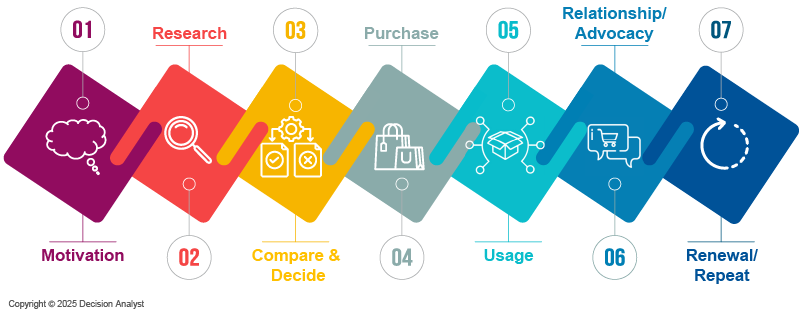One Woman’s Story of An Evolving Shopper Journey
Over the past year or so, I’ve been on a journey for new healthcare providers. Fortunately, my journey was not triggered because of a major health condition or health issue.
Rather, I found myself searching for something more from my healthcare providers. Like all of us, I’m not getting any younger, and while I don’t have any major health issues, I’m experiencing bumps in the road that are driving the importance of feeling “heard” by my doctors.
Being actively engaged in my journey to find medical providers got me thinking about shopper journeys and the path to purchase. While these frameworks are often applied to retail or consumer goods, they are relevant to nearly any product or service, and they apply in both the consumer and B2B realm. At Decision Analyst, our customer journey framework includes the 7 steps in the image below.

Need
Any purchase journey begins with a trigger or a need. Once the trigger happens, the journey, which can be simple or complex, begins.
For my healthcare provider hunt, my trigger was subtle. After each doctor’s visit, I was frustrated, uneasy, and disappointed. As I mentioned earlier, I felt like my doctor wasn’t hearing me. Finding new doctors is not fun or easy. In fact, it’s quite inconvenient, but once my frustration outweighed the inconvenience of trying to find someone new, my search began.
Shop, Compare, Choose
Once the need is identified, the next step is exploring options. When searching for healthcare, this can be heavily influenced by health insurance. Insurance may act as both a gatekeeper and a guide. Consumers often start by consulting their insurance provider’s network which narrows choices to those healthcare providers covered under their plan. For many, their health insurance significantly shapes the consideration set, but not always.
Finding a new healthcare provider is a very personal search that is impacted by both rational and emotional considerations. However, this rational and emotional connection is not unique to this type of journey. In fact, they both play a role in every purchase decision to differing degrees. As shoppers, our relationship with a brand, the utility of a product or service, availability and willingness to accept substitutes, and outside influences all have roles in the purchase decision.
In my case, my search was guided by recommendations from friends and family, reading patient reviews, and looking to avoid pain points that I experienced in the past. For some issues that I wanted to address, my health insurance (a rational element) wasn’t even part of my decision criteria. Emotional need fulfillment was the primary driver.
My point is, each shopper’s journey may be unique; however, often there are patterns in terms of touchpoints and criteria that influence the decision. Once identified, brands can leverage these to positively affect the outcome.
Research to uncover touchpoints, rational criteria, and emotional connections for this part of the path to purchase is often best suited to exploratory qualitative research. In-depth interviews, shop-alongs, or focus groups are great ways to do this. Once identified, quantitative research, through survey data, website analytics, or decision-tree analysis can be used to measure or validate behavior patterns.
Usage, Relationship Building, Repeat Purchase
Once the shopper has evaluated their options and the purchase is made, the next phase of the journey begins. The customer uses the product or service they’ve invested in, and if all goes well, they are satisfied or even delighted with their choice. The door is open to build a relationship; and the best products and services nurture the relationship through a positive customer experience to ensure repeat business and ideally develop a consumer advocate.
Leveraging What’s Learned
Effective shopper journey research is more than understanding consumer behavior. It can inform marketing, improve merchandising, personalize engagement, even inform future product and service development, all to enhance the customer’s experience and increase their lifetime value.
For healthcare providers, consumers are increasingly behaving like shoppers in other categories. Many are taking a dynamic journey shaped by personal needs, digital and in-person touchpoints, and insurance constraints. Consumers’ expectations for convenience, clarity, transparency, and personalization are growing, and consumer insight can help providers meet these expectations, fostering trust and loyalty in a competitive landscape.
So, what about me and my journey? Well, I found a practice that is meeting and exceeding my expectations for my biggest areas of concern. I ultimately selected a provider referred to me by a friend, and I happily share my experience with others. The provider is not part of my health plan’s network; in fact, they aren’t in any network. Part of the reason why they can offer the patient experience that they do is their unwillingness to be constrained by the current health insurance framework, but that’s a blog for another day!
Author
Julie Trujillo
Senior Vice President
As a research consultant with over 20 years of experience, Julie provides strategic direction to clients who are struggling with difficult business challenges. Julie guides her clients to identify the business questions and then designs research to get answers. Julie’s experience includes quantitative and qualitative research across an array of categories and research techniques. Julie holds a Bachelor of Science in Business Administration, with a concentration in Marketing, from Valparaiso University.
Copyright © 2025 by Decision Analyst, Inc.
This posting may not be copied, published, or used in any way without written permission of Decision Analyst.


